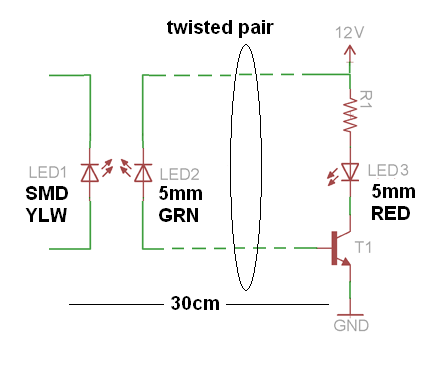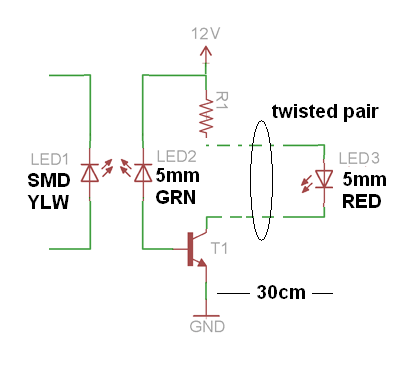LED extender question
I need to "move" (extend / expand?) the smd LED1 hidden inside the box so it can be visible from a front panel.
I planned to use a fiber-optic pipe glued to LED1 but decided otherwise due to several other factors.
So here's my idea of doing it using a minimum number of components. Any comments?

Correction: it should rather be LED3 moved away from all other circuitry by 30cm.

I planned to use a fiber-optic pipe glued to LED1 but decided otherwise due to several other factors.
So here's my idea of doing it using a minimum number of components. Any comments?

Correction: it should rather be LED3 moved away from all other circuitry by 30cm.



Comments
Alternatively, use a phototransistor to pick up the yellow LED output. Heck, you could even kick it old school with a non-RoHS cadmium photocell, which is coincidentally most resposive to yellow-green light.
Why wouldn't you just extend the LED with a cable, nothing else. I don't get what you are trying to do with this arrangement here though and why different color LEDs? I have used LEDs as photodetectors (reverse current or forward voltage) but this arrangement here is far from it.
BTW, the plastic tube that can be used to pipe the light is not fiber-optic at all, it's just a light pipe.
http://www.mouser.com/Optoelectronics/LED-Indication/LED-Panel-Mount-Indicators/_/N-b1d1pZscv7?Keyword=leads&Ns=Pricing%7c0
I know, but I that +12V has to come from somewhere too. The different color LEDs just didn't make sense, I'm sure that an LED is most sensitive to light of the same wavelength as it. Also the minute reverse current through the receiver LED might just work if you had a very bright light but very unlikely with the source specified. The transistor is not even biased either but is better off being replaced with a comparator or opamp, then it would have a chance.
Now both LEDs will come on
-Phil
Oh great one of all things opto-technical: have you ever used a Light-activated SCR? From what I understand they used to be popular in slave photoflash units. Exceptionally rare & hard to find these days, especially at the price I want to pay.
That T1 was supposed to be a Darlington...
Now, photo-Darlington is what I need for sure!
The whole idea is to make minimum (read:zero) modification to the pcb that has that yellow LED1, yet to extend LED1's visibility range to exhibit its"brightness" a short distance away.
Hence the contraption emulating light pipe. Also, there is 12V available so no problem with powering it.
That is exactly my objective.
You could have a darlington then but that requires at least 1.2V Vbe threshold before it even starts to think about conducting. A photodarlington is more realistic though but still, I would just solder to the pcb. Why can't you do that?
Unfortunately I cannot solder anything to that proprietary pcb hence all that gymnastics to accomplish it kinda "remotely"
The two transistors are actually a single, integrated photo-Darlington.*
-Phil
Update: * Well, maybe not. DigiKey's selection of photo-Darlingtons seems to be limited to IR-sensitive types.
Or perhaps a "pair" of visible light PIN diode + 2N3904?
http://www.digikey.ca/product-highlights/us/en/vishay-tefd4300-pin-photodiodes/1248
While this circuit is designed for an AC signal (or fluctuating signal) , it might be ok if you are just wanting a visual indicator effect.
http://forums.parallax.com/showthread.php/149216-DEMO-IR-Heartbeat-detector
In the circuit above the IR receiver is reverse biased in a way very similar to your first post. The two NPN transistors form an auto biasing circuit.
I'd have to R&D the circuit a little bit for the best configuration for driving an LED but it shouldn't be too painful.
Thanks Beau - I'll be waiting for the results!
Note: Circuit is very sensitive... reduce value of 1Meg resistor to de-sensitize
Reference: IR LED used for test.
http://www.ebay.com/itm/10Pcs-5mm-940nm-IR-infrared-Receiving-LED-Lamp-/140909599066?pt=LH_DefaultDomain_0&hash=item20ceddd95a
The circuit works lovely as an IR pulse detector with one-shot trigger characteristic and LED blinking upon receiving IR-pulses from any tv remote control.
However, when placed near powered up LED of any colour it does not detect it at all. Not even a single blink.
I suspect that it has to do something with my BPW-41 IR PIN diode that cannot see single spec wavelength of LED.
I tried another model (Telefunken and Siemens) and still no cigar.
Although it works just fine as an incandescent or plain bulb light detector.
Beau - did I miss something when modifying your schematic?
-Phil
I also tried the reversed biased LED to act as the front end detector for the matching colour xmtr but with the same negative results.
-Phil
I've always used LEDs as photodetectors in the photovoltaic mode, never in reverse. The LED's cathode is grounded and the anode is fed directly into the base of a transistor although it could be a darlington though I've never tried it.
Yeah, the same here - but I sort of focused on Beau's circuit
The Darlington circuit was also too sensitive as I need an ON/OFF only.